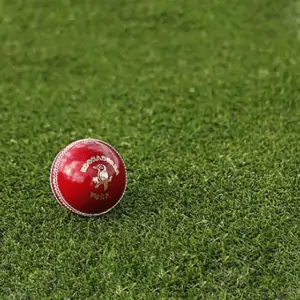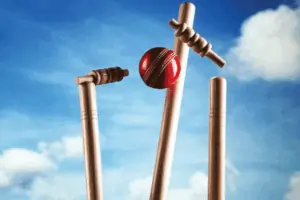Which Ball is Used in ICC Tournaments
In ICC (International Cricket Council) tournaments, the type of cricket ball used is typically a red ball for Test matches and white ball for One Day Internationals (ODIs) and Twenty20 Internationals (T20Is). The type of ball used in ICC tournaments depends on the format of the match. In Test matches, the ball used can vary depending on the location of the match. Most countries use the Kookaburra brand ball, while England, Ireland, and the West Indies use Dukes brand balls. For limited-overs matches like ODIs and T20Is, a white Kookaburra ball is used universally across all ICC tournaments.
Also, read about Exploring the Area Behind the Stumps in Cricket
Evolution of Cricket Balls
A Journey Through Time
The history of cricket balls dates back centuries. Originally, cricket was played with rudimentary balls made of cork, string, and leather. These primitive balls lacked consistency, making it challenging for players to gauge their performance.
Materials Used
Over the years, cricket ball materials have evolved. Today, cricket balls are primarily made from high-quality leather stitched together in a specific pattern. The leather is tanned and dyed to achieve the distinctive red or white color.

Discover more about Top 10 Fastest Stumping in Cricket History
Key Changes Over the Years
Cricket balls have undergone several significant changes. The transition from handmade balls to mass-produced ones brought uniformity. Additionally, advancements in manufacturing techniques and materials have enhanced the durability and performance of cricket balls.
White vs. Red Cricket Balls
Day-Night Matches
The choice between white and red cricket balls is crucial in day-night matches. White balls are preferred for their visibility under floodlights, ensuring a fair contest between bat and ball.
Swing and Seam Movement
Both white and red balls exhibit different characteristics in terms of swing and seam movement. Seam bowlers often prefer the red ball, which tends to offer more pronounced movement off the pitch.
The Kookaburra Ball
A Preferred Choice
The Kookaburra ball is a popular choice in ICC tournaments. Known for its uniformity and durability, it is the preferred ball for many international teams.
Characteristics and Advantages
The Kookaburra ball is designed to provide a good balance between bat and ball. It offers consistent seam movement and is known to maintain its shape even after extended use.
The Dukes Ball
The British Connection
The Dukes ball, with its British origins, has gained prominence in Test cricket. It is renowned for its pronounced seam movement and ability to swing even in English conditions.

Its Impact on Test Cricket
Test matches in England often see the Dukes ball in action. Bowlers relish the Dukes ball’s ability to challenge batsmen and create thrilling encounters.
The SG Test Ball
India’s Contribution
India’s contribution to cricket includes the SG Test ball, which is widely used in the subcontinent. It is known for its exceptional durability and pronounced seam movement.
Unique Features
The SG Test ball’s unique red color and pronounced seam make it a favorite among spinners and seam bowlers alike.
ICC Tournament Regulations
Ball Specifications
The ICC has stringent regulations governing the size, weight, and performance of cricket balls used in tournaments. These regulations ensure a level playing field for all teams.
Approval Process
Cricket ball manufacturers must meet ICC standards and go through a rigorous approval process before their balls are used in international matches.

The Importance of Ball Selection
Home Advantage
Host nations often have the privilege of choosing the type of ball used in ICC tournaments, giving them a home advantage.
Conditions and Pitch Types
The choice of ball also depends on playing conditions and pitch types, influencing the balance between bat and ball.
Manufacturers and Sponsorships
The Competitive Market
Several manufacturers compete to supply cricket balls for ICC tournaments. These manufacturers also enter sponsorship deals with cricket boards and teams.
Sponsorship Deals
Sponsorship deals play a crucial role in the cricketing world, with manufacturers vying for visibility through their association with international teams and tournaments.
Bowlers’ Perspective
Grip and Release
Bowlers must adapt their grip and release depending on the type of ball they are using. Different balls require different techniques to extract maximum performance.
Strategies Based on Ball Type
Bowlers often strategize based on the characteristics of the ball, exploiting its strengths to gain an edge over batsmen.
Batsmen’s Dilemma
Adapting to Different Balls
Batsmen face the challenge of adapting to different balls, each with its unique behavior. This requires quick adjustments and a keen understanding of the ball’s characteristics.
Challenges Faced
Facing high-quality bowling with varying ball types can be a daunting task for even the most seasoned batsmen.
ICC World Cup and T20 World Cup Balls
Customizations for Big Events
ICC World Cup and T20 World Cup balls often feature customizations, such as different colors or special graphics, adding to the excitement of these global tournaments.
Records and Milestones
Many cricketing records and milestones have been achieved using ICC tournament balls, adding to their legendary status.

Conclusion
In the world of cricket, the choice of the cricket ball is far from trivial. It is a decision that can sway the balance of power in a match and create memorable moments in ICC tournaments. The evolution of cricket balls, from humble beginnings to modern marvels, has been a fascinating journey that continues to shape the game we all love.
FAQs
What is the primary difference between white and red cricket balls?
White balls are used for day-night matches due to their visibility under floodlights, while red balls offer more pronounced swing and seam movement.
Why is the Kookaburra ball preferred in international cricket?
The Kookaburra ball is known for its uniformity, durability, and balanced performance, making it a favored choice among international teams.
What makes the Dukes ball suitable for Test cricket in England?
The Dukes ball is renowned for its pronounced seam movement and ability to swing, making it ideal for challenging conditions in England.
Why is the SG Test ball popular in the subcontinent?
The SG Test ball is favored for its durability and pronounced seam movement, which suits the playing conditions in the subcontinent.
How do bowlers adapt their strategies based on the type of ball used?
Bowlers adjust their grip, release, and strategies to maximize the performance of the specific ball they are using, exploiting its unique characteristics.



